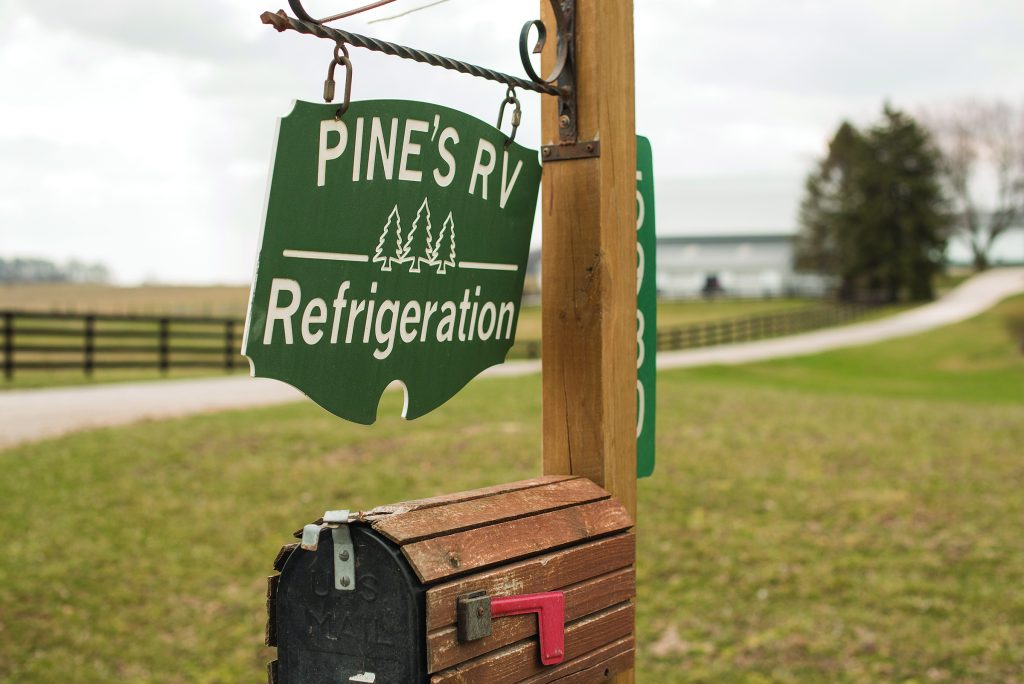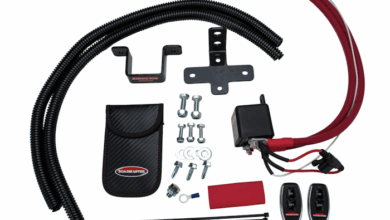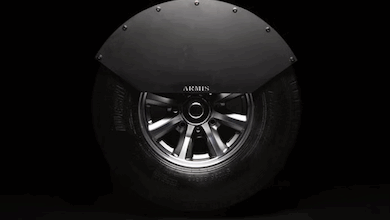Keeping It Cool

Fifteen years ago, Larry Miller made a “cool” career change.
That’s when Miller decided to convert the barns and sheds on his farm in northern Indiana from raising livestock to producing remanufactured cooling units for RV refrigerators.
“I bought this business in March 2003, and we’ve slowly built it up,” says Miller, owner of Pines RV Refrigeration in Shipshewana, Ind. “Some years it was faster than others, but every year, we’ve had growth.”
In addition to rebuilding cooling units for RV refrigerators, Pines RV also completes the assembly of new refrigeration units built by JC Refrigeration, a company owned by Miller’s brother-in-law, JR Lambright. Those new units are sold at the wholesale level under the Dutch Aire label.
“My brother-in-law is a half-mile from our location. He builds the new cooling units for me,” Miller says. “He bends them, welds them together, charges them, test-runs them and paints them. I’ve got the foam package and insulation package, and we put that on here.”
Responding to a Need
There is no good data regarding the failure rate for RV refrigerator cooling systems. Still, it happens frequently enough to make it worthwhile for Miller and a few other small players to sell remanufactured units to dealers.
As for why RV refrigerator cooling systems fail, the causes are varied. Most of the time, the failure of an RV refrigerator cooling unit is caused by leaks in the steel tubing because of rust-through or a broken weld, according to Miller.
“We strip them down, sandblast them, and the pipes that are leaking we cut out and replace with new tubing,” he says.
Miller says cost is the primary reason why consumers and dealers consider purchasing a remanufactured cooling unit versus buying a brand-new refrigerator. Generally speaking, it costs about half as much as buying a new refrigerator, according to Miller.
Smaller RV refrigerators cost about $1,500 a piece, and the 12- or 14-cubicfoot models can run $4,000, according to Miller. If a dealer replaces the cooling unit in a customer’s RV, the parts and labor add up to $700 to $900 for smaller refrigerators and $1,800 to $2,200 for large ones, he adds.
Additionally, replacing a cooling unit can be a much easier process than replacing a large refrigerator, which can require removing an RV’s windshield or slide-out if it won’t fit through the vehicle’s door, according to Miller.
Sometimes, though, it does make sense to replace the whole refrigerator if it’s aging ungracefully or has multiple problems, he adds.
Pines RV Refrigeration ships units all across the country.
“Most of our business is smaller mom-and-pop RV dealers,” Miller says. “It seems the bigger dealers, the bigger service centers, they buy most of their stuff through distributors.
“As we stay in business, we get more name recognition,” he says. “We’re growing, and we’re happy. It seems at least once a week there’s a new dealer that sets up an account and is buying cooling units.”
Just in the past year, Pines RV Refrigeration started supplying new Dutch Aire units to Meyer Distributing, which is the first time Miller has worked with a traditional distributor.
“I’m definitely thinking if it goes like I think it will, it’ll be a good thing for us and for them,” Miller says.
Meyer Distributing has about 60 locations throughout the country, which Miller says will help with the timeliness of deliveries. If an RV owner’s fridge goes out in California, he or she will want it fixed right away, but it takes five business days to ship a unit to the West Coast, he says.
“With Meyer Distributing, if a dealer orders a unit one day, they’ll have it the next,” he says. “I’m guessing with that time issue, it definitely could be a big hit out on the West Coast.”
Miller says his company also works with RV Cooling Unit Warehouse, a company in Mississippi that caters more to the do-it-yourselfer.
“We sell to him, and he sells to RV owners,” he says.
Miller says his company sold approximately 3,700 new and remanufactured cooling units last year.
“We’re still selling more remanufactured than new, but over the years, the new ones are getting more popular,” he says.
During the lean years of the Great Recession, Miller says business was good for Pines RV because people weren’t buying new RVs or new refrigerators but instead were fixing what they had. One year, sales almost doubled, he says.
Still, Pines RV is a small operation. Miller’s company keeps up with the work with a crew of six, including himself. One worker mostly does the welding, another sandblasts, paints, pressurizes and tests the units, while yet another does the foam packs and gets the units ready to ship.
Two of those employees are sons Derek, 22, and Jared, 17.
“I’m just floating around here keeping everything going,” Miller says of his role in the process. “I like to do a little bit of everything. … I guess you could call me the maintenance man. I troubleshoot and fix it.
“I kind of like to keep my nose in all the different things to make sure everything’s working properly and producing like it should,” he adds. “I like to have my hands dirty and work.”
Pines RV Refrigeration has expanded five or six times in the 15 years that Miller has owned the company.
“The first building that I worked in was a 24-by-44-foot building, 1,056 square feet,” he says. Now, after an expansion for a loading dock was completed a few months ago, the company has more than 20,000 square feet in two buildings. One building is an office-warehouse, and the other is the production building.
At Home on the Range
Pines RV is based on the 40-acre family farm where he grew up and where he lives with his wife, Lisa, and their six children. Every time Miller wants to expand, he has to go through the county variance process.
“I could keep on building, but there might be a time when we move everything to a more commercial, bigger building,” he says. “But I kind of like it here. It’s my home.
“I can remember when we had dairy cows that we milked and 15 acres of hay and corn that we grew every year,” he says, “and us and the neighbors helping each other farming.”
Not only is Shipshewana in the region of the country where an estimated 80 percent of American RVs are built, but it’s also in the middle of Indiana’s Amish country.
Miller, who is Amish, says he got his first steady job at age 16 with his brother-in-law, who was fixing the refrigerators that the Amish families in the area use. The Amish’s propane-powered refrigerators use absorption systems, rather than compression, and are similar to the units installed in RVs.


After about four years, Miller got married and spent some time building RVs in the Jayco and Keystone factories nearby. By 2003, Miller’s brother-in-law was getting so busy that he offered to sell part of his company to Miller, who then went into business for himself.
All of Miller’s employees are Amish, and some of them follow the work schedules established at the RV factories, where many Amish men work.
“One of my guys, he starts at 4:30 in the morning; others start at 5:30 and work till 2,” he said. “I’m usually out here from 4:30 to 4:30, to try to cover everybody. I feel obligated to do that.”
What might appear to outsiders as an anomaly – Amish workers building and repairing vehicles that they can’t drive themselves – is a commonplace in the region. By some estimates, more than half of the men from two Amish communities in northern Indiana work in the factories, bringing home salaries to make up for the increasing difficulty of earning a living at farming. And while the Amish culture eschews modern conveniences such as electric lights and motor vehicles, some Amish families own RVs, Miller says.
“Some Amish do. They’ll hire somebody to pull it to an RV park, and when the week is over, they’ll hire them to pull it back home again,” he says.
Miller’s family uses propane for lighting at home and travels locally in a horse and buggy. In the shop, he uses a generator for electricity. He uses a telephone and email sparingly at work, and his company has a website.
Acknowledging that different Amish communities accept varying levels of modern conveniences, he says many of the Amish in his area operate businesses that interact with the wider world.
“To actually have a successful business, we’ve got to communicate – with email, cellphone, fax, whatever,” he says. “Other areas are more farm-based, and they don’t have a need for that.”
Miller says that, as a Christian, he strives to do the best he can with his business.
“I feel we’re not cutting corners, and we’ve got the best product on the market,” he says. “They’re all individually welded; it’s not like a high-production operation. We test-run all our cooling units.”
Because it’s a small shop, Miller says he can control the quality of his products.
“We try to do quality work and don’t take any shortcuts. That’s the No. 1 thing – quality.”



